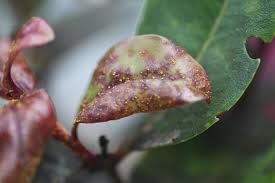
`ohi`a; photo by J.B Friday, University of Hawaii
As I blogged in December, APHIS is seeking input on a proposal to place several plant taxa in the category “not authorized pending pest risk analysis” (NAPPRA). The purpose of this proposed listing is to prevent introduction of plant pests or probable invasive plant species.
I urge you to comment before the deadline – this Friday, January 24.
In comments prepared for the Center for Invasive species Prevention (CISP), I applauded APHIS’ continued reliance on this authority to improve phytosanitary protections for our natural and agricultural resources. I noted, however, several weaknesses in the proposal – including several pathogens that I think should have been included, but were not. I summarize these comments here.
1) There have been lengthy delays in proposing and finalizing lists of species to be regulated under this authority. While I strongly support listing of all plants in the family Myrtaceae that are destined for Hawai`i in order to reduce the risk that additional strains of the `ohi`a rust pathogen Austropuccinia psidii might be introduced and prove more damaging to native Hawaiian vegetation than the strain already present on the islands. However, this proposal comes 15 years after the pathogen was detected in Hawai`i and six years after publication of scientific documentation of the existence of more damaging strains of the pathogen.
2) When lists have been presented, they failed to include all appropriate species.
I am disturbed that APHIS did not include in the NAPPRA proposal Ceratocystis lukuohia and Ceratocystis huliohia, two pathogens that are killing millions of ‘ōhi‘a trees in Hawai`i under the name “rapid ‘ōhi‘a death”.
3) APHIS must act under other regulatory provisions to close some of the gaps left by this proposal.
The listing of plants in the Myrtaceae (see number 1 above) under NAPPRA does nothing to halt imports of cut flowers and foliage, which are widely recognized to be the pathway by which the rust was introduced to Hawai`i. APHIS notes that is should act under other regulatory authority to close this pathway; I hope you will urge APHIS to take such action quickly, preferably initially by issuing a Federal Order.
4) APHIS has proposed 26 plant taxa for inclusion in the NAPPRA category because they might themselves be invasive. These proposals are generally well supported and deserve your support. Several plant taxa appear to pose significant ecological threats: two taxa of mangroves (Bruguiera gymnorhiza and Lumnitzera racemose); a vine that grows in Asian and Indian Ocean mangrove forests, Derris trifoliate; and several aquatic plants (Crassula helmsii, Elatine ambigua, Luziola subintegra, Philydrum lanuginosum, Stratiotes aloides); and Ligustrum robustum.
Remember that at least 50 species of aquatic plants are already considered invasive in the United States. At least eight species of Ligustrum are also invasive.
Update: Listing finalized
On June 2, 2021 APHIS finalized the NAPPRA listing originally proposed in November 2019.
The agency added to the category 26 plant taxa because they are invasive; all plants in the Myrtaceae family when destined to Hawai`i, and 43 other plant taxa that are hosts of 17 quarantine pests.
The only change from the proposed action was to drop listing of the subfamily Bambusoideae because it is already regulated under NAPPRA to prevent introduction of other quarantine pests.
APHIS had received 132 comments from producers, importers, industry groups, conservationists, scientists, plant pathologists, ecologists, administrators, teachers, students, and private citizens. Most reportedly supported the proposed listing of Myrtaceae destined for Hawai`i and expressed no concerns about the proposed listing of most other taxa. I have blogged previously about the threat to Hawaii’s unique flora posed by the pathogen Australopuccinia psidii (the subject of this NAPPRA listing) and other non-native organisms – here and here.
A complete list of taxa listed under NAPPRA and the resulting restrictions on importation is posted at https://www.aphis.usda.gov/aphis/ourfocus/planthealth/import-information/permits/plants-and-plant-products-permits/plants-for-planting/ct_nappra
Posted by Faith Campbell
We welcome comments that supplement or correct factual information, suggest new approaches, or promote thoughtful consideration. We post comments that disagree with us — but not those we judge to be not civil or inflammatory.
For a detailed discussion of the policies and practices that have allowed these pests to enter and spread – and that do not promote effective restoration strategies – review the Fading Forests report at http://treeimprovement.utk.edu/FadingForests.htm
What types of plants are there?
“sudden oak death” pathogen — over 100 species of plants are recognized as hosts. These include several west-coast maples, madrone, manzanita, European ash, Japanese larch, bay laurel, tanoak, coast live oak, canyon oak, southern red oak, Holm oak, canyon black oak, Shreve oak
and such common ornamental plants as camellia, rhododendron, mountain laurel, pieris, lilac, viburnum
you can probably get a host list by visiting APHIS’ website